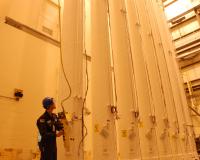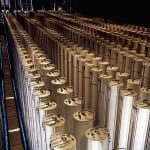By Kennedy Maize
USEC, the Bethesda, Md., uranium enrichment company that took over the Department of Energy’s enrichment program in 1992 is claiming that the Obama administration is reneging on promises to provide $2 billion in loan guarantees for the company’s “advanced” centrifuge enrichment plan, made during the 2008 presidential campaign.
DOE’s decision to withhold the loan guarantees authorized in the 2005 Energy Policy Act was based, the agency said, on a judgment that the centrifuge technology wasn’t not yet ready for the market. Without a new, lower-cost enrichment process, USEC likely will die, as it is tied to the high-cost, inefficient World War II gaseous diffusion cascades for enriching uranium developed during the Manhattan Project.
.USEC’s initial business strategy when it “bought” the DOE enrichment business (it was a fire sale), was that a new technology — “Advanced Vapor Isolation Laser Separation” or AVLIS — would transform the costs of uranium enrichment. When USEC inherited AVLIS, the company believed that the focused-laser technology would guide its way out of the old, costly, and inefficient World War II enrichment technology. By 1994, the belief in AVLIS had faded and USEC sold AVLIS to General Electric.
Then USEC turned to the advanced centrifuge technology that DOE had been developing at its site in Pikeston, Ohio. Europeans had been successfully developing gas centrifuges to enrich uranium — the centrifuges spin out the heavier U238 atoms from the lighter U 235 atoms in order to concentrate the heavier atoms more likely to spit apart and yield heat energy.
DOE was developing its own centrifuge technology, centered in Pikeston (for a number of reasons, most of them political). But, typical DOE thinking, the approach was big spinning machines. The Euros had concentrated, successfully, on many, many, many small centrifuges. DOE’s approach, which won funding in Congress, was fewer, bigger machines (bigger is better).
But there was a nasty technical problem. The bigger machines had bigger spinning masses. They tended to blow apart. The technical program went nowhere and Congress eventually killed the project. It’s another case of “live by the government, die by the government” that is a major theme in U.S. energy history. AVLIS didn’t work out and the prospects for big centrifuges looked very dicey.
USEC sold the AVLIS technology to General Electric, which is working on developing it. In the meantime, the enrichment company focused on the abandoned large centrifuge technology, and got an earmark in the 2005 energy bill for a $2 billion loan guarantee. President Obama campaigned in Ohio in 2008, pledging to support the centrifuge program.
DOE rejected the USEC loan guarantee application in late July, saying the application “would likely not meet the legal requirements of the 2005 EPACT statute” and the subsequent DOE regulations. The problem, DOE concluded, was that the USEC centrifuge technology wasn’t close enough to commercialization. It was, and had been for years, an R&D program, with no assurance of commercial viability.
USEC was outraged. CEO John Welch said the company was “shocked and disappointed” at the DOE decision. He cited some 235,000 hours of testing on the big centrifuges. But critics said the the USEC testing program was immature. The Washington Post http://www.washingtonpost.com/wp-dyn/content/article/2009/07/28/AR2009072802617.html quoted Matt Rogers, a DOE official, that USEC had settled on a design for the centrifuges and tested only 38 of the 11,000 needed for the plant. “The project runs the risks of either major cost overruns or reliability problems, or both,” he said.
USEC http://www.usec.com/NewsRoom/NewsReleases/USECInc/2009/2009-07-29-USEC-To-Pursue-Discussions.htm said it is beginning the process of dismantling its centrifuge plant, and, as the same time, appealing DOE’s decision to deny loan guarantees.
The failure to get loan guarantees for the new technology could spell the end of USEC. The company’s common stock plunged dramatically at $2.15 per share to $4.05/ share after the DOE announcement, wiping out some $240 million in company market share.
The value of the company, some analysts noted, was in its future of uranium enrichment technology, not the past and current practices. Said one trader, “If USEC is stuck with the World War II cascades, the company is finished. Euro enrichment can flush USEC out of the market on the cost of [separative work units] as new fuel contracts come due.”








